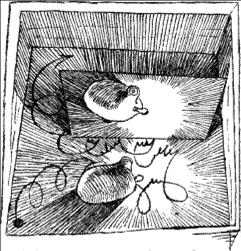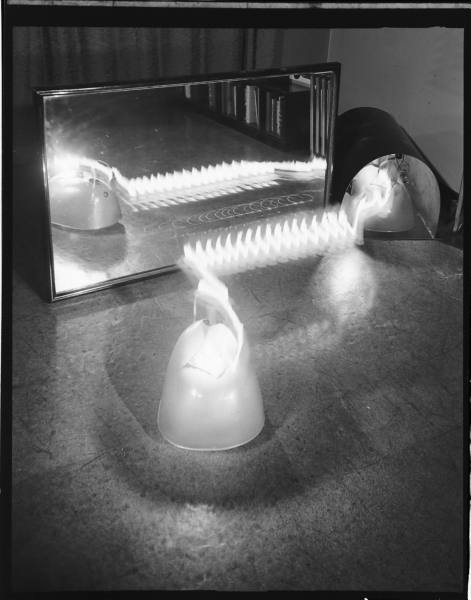Self-recognition and the Mirror Dance

[Image source: An Imitation of Life, Scientific American, May 1950, p42-45.]
7 . Self-recognition. The machines are fitted with a small flash-lamp bulb in the head which is turned off automatically whenever the photo-cell receives an adequate light signal. When a mirror or white surface is encountered the reflected light from the head-lamp is sufficient to operate the circuit controlling the robot's response to light, so that the machine makes for its own reflection; but as it does so, the light is extinguished, which means that the stimulus is cut off — but removal of the stimulus restores the light, which is again seen as a stimulus, and so on. The creature therefore lingers before a mirror, flickering, twittering, and jigging like a clumsy Narcissus. The behaviour of a creature thus engaged with its own reflection is quite specific, and on a purely empirical basis, if it were observed in an animal, might be accepted as evidence of some degree of self-awareness. In this way the machine is superior to many quite 'high' animals who usually treat their reflection as if it were another animal, if they accept it at all.
Source: p115, W. Grey Walter, The Living Brain, 1953 -see chapter 5 – Totems, Toys, and Tools
What can be seen or determined in the photo of Elsie below?
1. tracer candle visibility;
2. low batteries (because it enters the hutch which is strategically placed to the right of the mirror).
Figure 7. Elsie performs in front of a mirror, but is probably responding to the candlelight rather than to her pilot light. [RH 2010 -Most earlier comments by others are of this rather un-clear image of the so-called 'mirror dance'.]
Prior to the release of the clearer Life image of Elsie performing the 'mirror dance' (see pic below) Holland in "Legacy of Grey Walter" describes it as follows:
Recognition of self
A pilot light is included in the scanning circuit in such a way that the headlamp is extinguished whenever another source of light is encountered. If, however, this other source happens to be a reflection of the headlamp itself in a mirror, the light is extinguished as soon as it is perceived and being no longer perceived, the light is again illuminated, and so forth. This situation sets up a feedback circuit of which the environment is a part, and in consequence the creature performs a characteristic dance which, since it appears always and only in this situation, may be regarded formally as being diagnostic of self-recognition. This suggests the hypothesis that recognition of self may depend upon perception of one’s effect upon the environment.
The below from Discussions on Child Development, 1971, see Book II 1954-56 p35-6.
p35.
With Fig. 6 we come to some of the refinements which emerged only some time after these creatures had been made. This mode of behaviour and the next one were, quite frankly, surprising to us though, of course, we ought to have been able to predict them. Fig. 6 illustrates the situation when a creature of this type is confronted by its reflection in a mirror. It has on its nose a small pilot light, put in originally to tell us what was happening inside; it is so arranged
p36.
that it is turned off when the creature sees another light; that is, it tells us when the photo-tropistic mechanism is in operation.
In this case, the light which the creature was allowed to see was its own pilot light in the mirror. In this situation, the act of 'seeing' it makes it automatically extinguish the light which it sees. The apparent stimulus light having been extinguished, it turns it on again, then off and so on, so that you get a characteristic oscillation. You can see how peculiar and regular it is by the zigzag going up the side of the mirror. This is an absolutely characteristic mode of behaviour, which is seen always and only when the creature is responding to its own reflection. This is an example of the situation I described in the second proposition, where the reflexive circuit includes an environmental operator; in such a situation you get a characteristic mode of behaviour which occurs always and only when the model is reacting to itself.
Narcissism
“The creature therefore lingers before a mirror, flickering, twittering and jigging like a clumsy Narcissus” (Grey Walter, 1963, p. 115). Grey Walter interpreted this famous mirror dance as evidence of self-recognition.

The drawing of the famous `mirror dance’ in `An imitation of life’ [from Scientific American] is nothing like the regular alternation between the tortoise's approach and avoidance as shown in the photograph, being an altogether more irregular and complex trajectory. There may well have been a mirror dance that could have been argued to be a form of self-recognition, but unfortunately this photograph cannot be said to be a record of it. The brightest light visible to the camera, and presumably to the photocell, is the candle on the tortoise’s back and its reflection in the mirror. The trace is far more likely to reflect the alternation of behaviour pattern P (approach to the reflected candlelight) with behaviour pattern O (obstacle avoidance on contact with the mirror). We can be sure that Walter used this image as an example of the mirror dance because it appears in the form of a diagram in the transcript of a talk he gave in 1954 (Walter 1956b); the text matches closely the account given in `Accomplishments of an artefact’. Interestingly, the description of the mirror dance in de Latil’s book also matches this photograph rather than Grey Walter’s original description and Bernarda Bryson Shahn’s sketch.
For most people, with regards to the image above (see figure 7), one could hardly refer to this behaviour as "flickering, twittering and jigging like a clumsy Narcissus". However, you could do so to the above illustration by Bernarda Bryson (partner and later married to the artist Ben Shahn), as illustrated in Scientific American (Walter, W. Grey, "An Imitation of Life," Scientific American, May 1950, p42-45.). The above illustration is actually of Elmer, and not Elsie as is the below photo. This also gives more credence to Grey's use of the word Narcissus, being the son of a Greek god who became obsessed by his own image. [Elmer scans clockwise, the opposite of Elsie and the bump aviodance traverse therefore is from right to left. see here.]
[Narcissus : In Greek mythology, a beautiful youth who fell in love with his own reflection. He was the son of the river god Cephissus and the nymph Leriope. His mother was told by a seer that he would have a long life, provided he never saw his own reflection. His callous rejection of the nymph Echo or of his lover Ameinias drew upon him the gods' vengeance: he fell in love with his own image in the waters of a spring and wasted away. The narcissus flower sprang up where he died.]
Although Elmer was then long gone, Grey Walter continued to use this more interesting description of self-recognition along with the below image, although it didn't and couldn't match with the sometimes erratic behaviour of the original tortoise, Elmer and could no longer be reproduced with the newer models.
In my opinion, in the cycloidal trace seen above, the 'bottom' of the cycloid appears flattened and bright spots at the start of the cycloid 'flats' appear. To me, this is indicative of 'bump' avoidance behaviour, not self-recognition. When I visited the Bristol Robot Labs in 2009 to see the replica tortoises, the comment was passed to me that they were unable to satisfactorily reproduce the self-recognition behaviour as described by Grey Walter.

A relatively recent , clearer image of the so-called 'mirror dance' as released by Life Magazine.
A comment on Time-Lapse Photographs in General:
In interpreting all the time-lapse photographs, there are several aspects to keep in mind.
As already mentioned in pervious posts on the Tortoises, the cycloidal gait makes Elsie traverse to the right as her scanner turns in a counter-clockwise direction. Elmer, on the other hand, scans clockwise and because of the trailing action of the rear-wheels, will veer to the left. I must say, though, that the illustrations suggest that with no light source to track towards, Elmer tends to move in a forward direction and not sideways.
Most of the pictures show Elsie heading towards a light, either a candle or the hutch light, sometime a light out of sight near the camera.
Where you see two identical Elsies, it is actually the photographer’s technique of photographing Elsie at the start of the run, then Elsie at the end of the run. There are not two separate Tortoises except where they look physically different i.e. Elmer has the ‘scaled’ Bakelite sheeting shell. The single trajectory is also an indicator of only a single Tortoise being traced.
Notice also that the flame of the target candle is placed at the same height as the PEC (the Photo-Electric Cell) in the scanning turret.